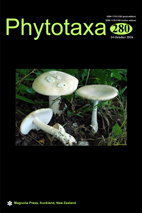Abstract
Phylogenetic relationships and species diversity within the genus Halymenia along the Brazilian coast were investigated through molecular and morphological analyses. Molecular studies included UPA, COI-5P and rbcL markers. A total of five Halymenia species were found: Halymenia cearensis sp. nov., H. ignifera, H. pinnatifida, H. silviae and H. cf. mirabilis. Halymenia cearensis was molecularly distinct from all other Halymenia species included in this study and is morphologically characterized by: cleft, lobate, oblong or obovate blades with broad base; apex irregular in shape; surface with bullations, rugosities, spiny and globular papillae irregularly distributed; abundant and conspicuous ganglionic cells throughout; blades up to 800 µm thick at base; outer cortical cells ellipsoidal or ovoid in shape, higher than broad; and inner cortex cells 4–25 µm in width. Our phylogeny demonstrated that entities attributed to H. floridana and H. elongata occurring in Brazil correspond to two distinct genera, which was also supported by morphological and ecological data. The use of molecular tools was crucial to provide a better understanding of the diversity of Brazilian marine flora.

